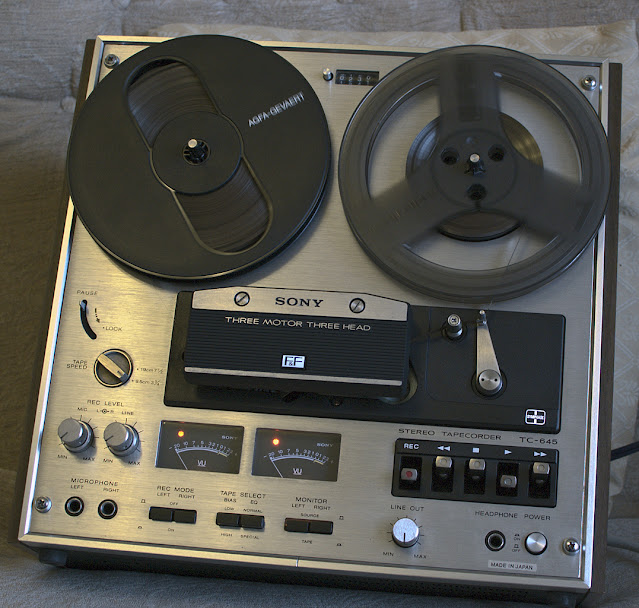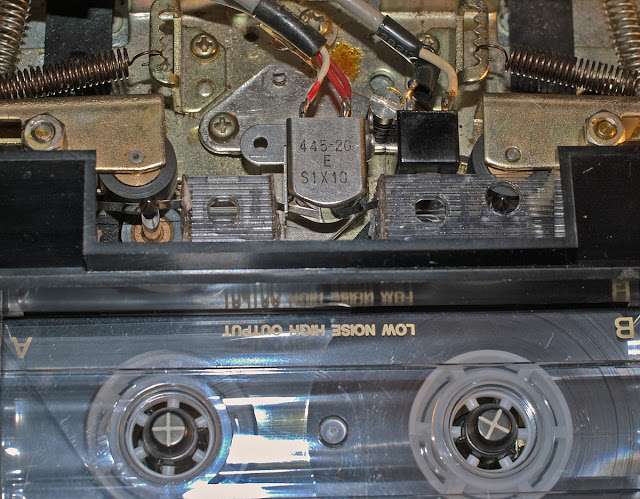Sony TC-645 Reel to Reel
This sentence in blue will be removed when this article is deemed to be finished. This is a work in progress. (July 2022)
Bought from ebay during July 2022.
Work completed on the 645 ...
- Complete clean main audio circuit board, including vacuuming.
- All mechanics and elbow joints freed and lubricated.
- Idler Gear cleaned, evenly 'roughed up' by rolling on to grit paper, and later Rubber Renue applied.
- All switches and potentiomters cleaned with Servisol Super 10 or direct equivalent.
- Complete electrolytic capacitor replacement - on audio board, bias oscillator, and power supply unit.

All capacitors and transistors in the
bias oscillator were also replaced.
Pictured with original components. - Complete transistor replacement - mainly using KSC1845-FTA, and KSC1815-GR where appropriate.
- All three motor start/run capacitors replaced.
- All switching capacitors replaced.
- Recording of high frequency audio compression and, or distortion fixed. (A pre-emphasis modification)
- Reel brake issues for supply and take up reels fixed.
- The groung rail on the recording audio section was not earthed, and so it exhibited a floating potential of about 22mV/24mV. The effect of this was to add a dc (erasing) bias to recordings through the record head.
Unresolvable Issue?: Tape rubs on leftmost part of erase head during FF and RW. Unless I can get the tape lifter bar to lift higher, there is going to be no change here.
Erase head wear was noticeable when I bought the machine. I lapped the erase head to remove the wear marks.
 |
| Before. |
 |
| After |
I will return to this at a later date.
 |
| As can be seen, the tape is still in contact with leftmost part of the erase head during both rewind, and fast forward. |
Reel Brake Pad Replacement
Reel braking was unsatisfactory, more successful on Fast Forward than Rewind. The old worn, and partially chemically perished pads were leaving marks on the surrounds of the tape recorder, so they had to be replaced.
I have found that cut-to-size chamois leather strips, bonded to doubled sided sticky tape is working well, and so far I've no reason to think that they will fail, at least not in the short term.
Users of the TC-645 with similar braking problems are advised to also check the T-section brake 'release line'. Here between the vertical arrows, the 'release line' must be allowed to easily rotate clockwise and anti-clockwise during operations.
Floating Ground within the Recording Audio Section
Buying and fixing old machines really throws up some quite unusual events. In this case, the ground rail was floating at around 22mV/24mV above the ground level of the playback audio section.
After carefully identifying all the grounding (0v) connection points on the main board, I eventually solved the issue of the recording head accidentally adding a small dc bias on to tape. The source of the problem appears to have been an inconsistent wired connection midboard.
 |
| Note: the capacitors on the solder side were only temporary. |
Recording Pre-emphasis Modification
At the time of writing the TC-645 has not been playback level calibrated, nor playback EQ (de-emphasis) calibrated using a full track 1/4" reference tape.
The possibility of a pre-emphasis issue arose when observing severe high frequency compression/distortion on playback of speech and music which was recorded on this machine. If I lowered the recording level to ~ -20dB OVU, the machine was able to cleanly record high frequency speech or music sibilances without trouble, however above -20dB and the recording sounded 'dirty' at the top end.
More to follow later on the topic of pre-emphasis (record equalisation), and de-emphasis (playback equalisation) for this machine.
Full Track 1/4" Alignment Tape
I purchased an alignment tape which I need to help calibrate this tape recorder. It is certainly possible to intelligently estimate record levels, playback levels, and playback equalisation - so this step is not absolutely necessary to get your machine 'basically' working.
However, since I've put so much work into restoring this machine, it's only proper that I calibrate this TC-645 as far as possible to get the best out of the deck.
Before any calibration is undertaken, we must of course demagnetise all tape paths, followed by demagnetisation of the record and replay heads. The heads, and all other points where the tape is in contact, must be cleaned for reliable calibration.
Alignment here assumes that the tape guides are correct, that is - the guides 'guide' the tape across the heads correctly. And the heads are correctly height aligned - see the Sony TC-645 service manual.
The full track alignment tape above is for Sony reel to reel machines with a '0VU' field strength of 185 nWb/m, which by default is set to give 0.775v (rms) output at 400Hz, and is to be marked as '0VU' on the VU meters.
Note: 'n Wb/m' = nano-Webers per metre.
However, as modern tapes are capable of stronger magnetisation, I wish to set '0VU' on this TC-645 to approximately 260 nWb/m. This means that I need to set the playback of 185 nWb/m to about -3dB on the VU scale, that is: 20·Log(185/260) = -2.96dB.
The procedure to achieve this was as follows: First turn the main output potentiomter fully clockwise on the front panel of the TC-645. Then run the reference tape at 7.5 ips (19cm/sec), and carefully turn the left channel (and later the right channel) playback 'PB' potentiometer so that the output of the deck reads 0.775 volts rms or approximately 1.1 volts peak on an oscilloscope. We would then normally adjust the VU meter calibration potentiometers to read '0VU', but on this occasion - set the VU meter levels to '-3dB' as shown above.
Playback Equalisation
The Sony's playback 'EQ' was (I believe) designed to follow the NAB playback curve, which I am led to believe is also called 'IEC2'?
Further along this full track reference tape there is a section which has a 400Hz tone, followed by a 10,000Hz tone in quick succession. I would then locate the playback (PB) EQ potentiometers (on the TC-645's circuit board) and trim so that both amplitudes of 400Hz and 10,000Hz are identical. In my case, I didn't need to, as I luckily guessed correctly!
However, according to the service manual this isn't the end of the subject - there are another set of frequencies to observe. They are: 40Hz, 80Hz, 7Khz, and 12.5Khz. On Sony's original J-19-F1 calibration tape similar tones are produced: 40Hz, 80Hz, 7Khz, and 10Khz, and fine EQ adjustments have to be made observing the playback levels of 40/80/7000/10000Hz and their deviation from the level obtained from 400Hz. The permittable deviations in dB units from the amplitude of 400Hz is specified in the TC-645 service manual.
They are ...
As can be seen, the service manual is somewhat ambiguous. What exactly is meant by '2 ± 2dB'? My interpretation is that it means +2dB ± 2dB, or 0dB to +4dB.
Okay, so then my procedure will be to adjust PB EQ so that 400Hz level equals the 10,000Hz level, then observe and make notes of the deviations when ...
(1) 10,000Hz level = 400Hz level ( 40Hz= , 80=Hz , 7Khz= , 12.5Khz= )
(2) 10,000Hz level is +1dB of 400Hz level ( 40Hz= , 80Hz= , 7Khz= , 12.5Khz= )
(2) 10,000Hz level is -1dB of 400Hz level ( 40Hz= , 80Hz= , 7Khz= , 12.5Khz= )
Perfect playback flatness will not be obtained, so a compromise will have to be reached.
Frequency Response
Tape Speed: 3.75 ips or 9.5cm/sec.
So far, using a Maxell UD 35-90 (35 micron, 90 minute) 1/4" tape which I purchased in 1989, at a recording level of -20dB (ref 260 nWb/m in this case), the frequency response stretches from 30Hz to 16,000Hz, at -3dB and less than 0dB respectively (ref: 400Hz). With a gentle rise beginning at around 2Khz/3Khz, peaking at about 7Khz (~2.5dB/+3dB) before dropping to +2dB at 10Khz, where finally sitting at over 16Khz at about 0dB.
Increasing bias and I obtain 30Hz (-3dB) to 16Khz (-2dB), and a smaller rise is returned at 10Khz of about +1.5dB/2dB. Observations were made on the oscilloscope, so they are only provisional at this moment.
Wow & Flutter
Tape Speed: 3.75 ips or 9.5cm/sec.
Using the now quite famous WFGUI.exe Windows program to compute wow & flutter figures, I recorded and played back a 3150Hz test tone at about -10dB. The returned value of W&F astonished me, as it was lower than factory specifications - between 0.03% and 0.04% wrms!
Possbily more to follow in the coming months .....
(Also subject to possible corrections, alterations, and amendments.)
cassettedeckman@gmail.com
















































